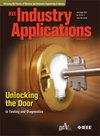A Novel Approach for Testing the Robustness of Networked Components in Vehicles Against Dynamic Power Supply Faults
IF 4.5
2区 工程技术
Q2 ENGINEERING, ELECTRICAL & ELECTRONIC
引用次数: 0
Abstract
Future automobiles will be characterized by automated driving features which demand an outstanding reliability of safety critical components. To ensure the needed safety in operation of the automated driving systems, the power supply must support a basic functionality in the case of a supply component failure. Typical component tests regarding the supply system are simplified and cannot consider the propagation of voltage pulses or drops along the power supply system and faulty system interactions. A new testing approach has been developed which considers these effects. The propagation of power supply system faults in a supply network are simulated first, and the time dependent voltage profiles are calculated for each attached electronic component individually. In a second step, voltage profiles gained from simulations are supplied by a highly dynamic voltage source to the electronic components and possible interactions are analyzed in this setup. The test method is presented and analyzed. In an exemplary automotive setup two redundant electronic components are interacting via the CAN communication bus. It is discussed how highly dynamic power supply system faults can lead to unexpected system interactions, not considered in today's testing approaches.一种测试车辆网络组件对动态电源故障鲁棒性的新方法
未来的汽车将以自动驾驶为特征,这就要求安全关键部件具有出色的可靠性。为了确保自动驾驶系统运行所需的安全性,电源必须在电源组件故障的情况下支持基本功能。供电系统的典型部件试验过于简化,不能考虑电压脉冲或电压降沿供电系统的传播和故障系统的相互作用。一种新的测试方法考虑了这些影响。首先模拟了供电系统故障在供电网络中的传播,并分别计算了各附加电子元件的电压随时间的变化曲线。在第二步中,通过高动态电压源将仿真得到的电压分布提供给电子元件,并在此设置中分析可能的相互作用。给出了测试方法并进行了分析。在示例性汽车装置中,两个冗余电子元件通过CAN通信总线进行交互。讨论了高动态电源系统故障如何导致意外的系统交互,而这在今天的测试方法中没有考虑到。
本文章由计算机程序翻译,如有差异,请以英文原文为准。
求助全文
约1分钟内获得全文
求助全文
来源期刊

IEEE Transactions on Industry Applications
工程技术-工程:电子与电气
CiteScore
9.90
自引率
9.10%
发文量
747
审稿时长
3.3 months
期刊介绍:
The scope of the IEEE Transactions on Industry Applications includes all scope items of the IEEE Industry Applications Society, that is, the advancement of the theory and practice of electrical and electronic engineering in the development, design, manufacture, and application of electrical systems, apparatus, devices, and controls to the processes and equipment of industry and commerce; the promotion of safe, reliable, and economic installations; industry leadership in energy conservation and environmental, health, and safety issues; the creation of voluntary engineering standards and recommended practices; and the professional development of its membership.
 求助内容:
求助内容: 应助结果提醒方式:
应助结果提醒方式:


